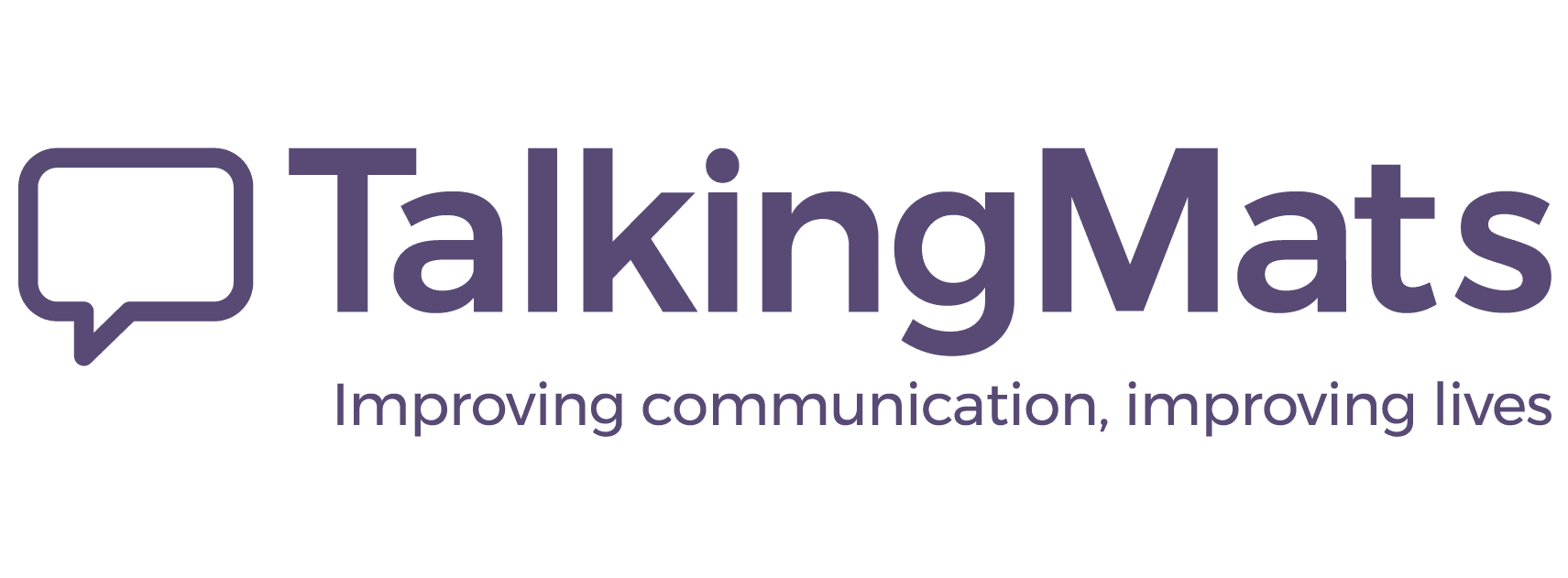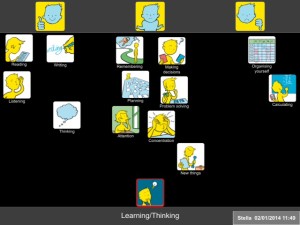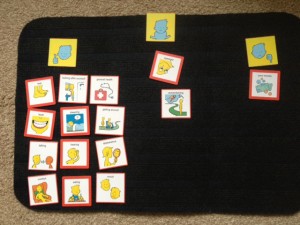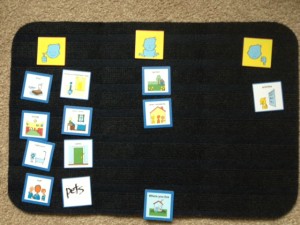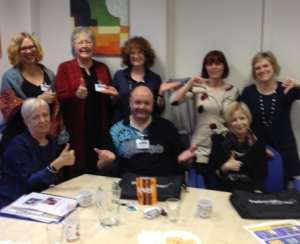The Talking Mats Team is increasingly asked to help ascertain a person’s capacity to express their views from a non-biased perspective. We are also asked to carry out service evaluations and are therefore developing independent consultancies to individuals and organisations. Our team of experienced Speech and Language Therapists, who have an in-depth knowledge of communication difficulties, are well equipped to do this.
The following are examples of independent consultancies which we have been asked to carry out:
- A lawyer asked us to work with a man who had had a severe stroke to ascertain his capacity to make decisions ranging from simple ones such as where he would like to go on holiday to complex ones such as who should control his finances. Using Talking Mats we were able to determine that he could make decisions about simple, concrete situations but wished his wife to make more complex decisions such as finances. check
- A Social Work department asked us to work with a woman with dementia and aphasia who had been sectioned. They needed to ascertain if she could understand why she could no longer live in her own home. We worked closely with her social worker and through using Talking Mats ascertained that she was unable to give informed consent.
- A Health Service facility asked us to evaluate the degree to which their patients felt involved in their care planning.
- A Care Home asked us to use Talking Mats with a 91 year old resident with dementia to find out her views about receiving dental treatment. There had been problems in the past and both the staff and her son were unsure if she understood the reasons and implications for dental treatment. Using Talking Mats, she was able to explain her thoughts about her teeth and dentures and clearly said that she was unhappy about opening her mouth for the dentist but that if her son were with her she would feel much better. We received this comment: “If you were to show the first few minutes without Talking Mats you would have thought this lovely lady lacked capacity, however the change and her engagement is noticeable.”
The following points explain with whom and how we can carry out the Talking Mats consultancy:
- Children or adults
- Family members, friends, professional staff
- Individuals or groups
- With or without a carer present
- At a venue and time which best suits the individual
- On any topic – we already have a comprehensive range of topics for both adults and children – but can create tailored symbol sets for any situation
- To find out someone’s views on a particular topic or situation at a specific point in time
- To help determine the capacity of an individual to make their own decisions
- To compare someone’s views over time
- To compare different people’s views e.g child and parent, person with dementia and carer
- We provide a detailed report with a copy of the person’s completed mat/s
To find out how we can help you and for discussion of costs please contact us at info@talkingmats.com or phone us at 01786 479511
“About half of all people with multiple sclerosis have some degree of problem at some time with aspects of thinking – memory, attention span or concentration. …. Many people may not recognise cognitive symptoms as an aspect of their MS and they can arise early in the course of the condition although the greater the disease duration and severity the more likely problems are to occur”. MS Trust
Talking Mats is one tool which can help people recognise any problems they may be having. It also provides a sensitive way for people to discuss these issues and plan ways to manage their situation.
We have developed a range of topics which encompass virtually all aspects of a person’s life
Insert mind map
The Learning and Thinking topic is particularly relevant. The following is an example of a Talking Mat done with Stella who has MS and lives at home with her husband and 3 children.
Top Scale Used: Managing: Need some help: Not managing
Stella began by putting most of the option symbols between the Managing and Need some help columns. However as more symbols were presented, she took time and thought about each symbol more carefully and changed her mind about many of them.
She said that using Talking Mats helped her realise that she was having some problems. On completion of the mat, she showed it to her husband and together they discussed practical ways of ways of managing her difficulties.
There are a further 12 topics in the Health and Well-being resource that can be helpful to people with MS. these are available either on our app or as Talking Mats original.
I undertook the ‘Talking Mats’ on-line course to acquire a new skill and a way to enhance my communication with people with dementia in practice. I have found the learning strategies used are varied and interactive – so there is not a sense of sameness, even though visually there is a consistent layout to the presentation of each module (this expedites navigation). This enhances engagement and my interest so that I am never reticent in logging on to complete the next module! In the beginning, I felt that I could move a lot quicker through the course if the modules were available once each part was completed, instead of having to wait for feedback on each assignment. However, nearing the end of the training course, the benefits of this approach are now clearer. Spaced learning and spaced practice allows for thinking time and internalisation of the module components. In this way, I have come to appreciate the part skills involved in the overall process and how they come together. I now find myself observing the skills involved and the reactions of all communicating as well as the surrounding environment, body language etc. I have also found myself looking back over the past module materials to ensure I am integrating as I go and to remind myself of the rationales for the actions that need to be taken, as well as ensuring that I am more and more familiar with the new terminology that I have been exposed too.
Little did I know when I signed up that the benefits of learning about and how to use ‘Talking Mats’ would stretch wider than what I initially anticipated or wanted! In completing the course, I am now much more aware of my communication practice in general, and the part-skills involved. I can also now see the wide applicability of ‘Talking Mats’ to different populations, age groups and conditions. Communication is everywhere but it needs to be efficient and effective – I am now more confident that my communication practice will improve as a result of this course. For me this is the best outcome possible.
Please click here to find out how to book on the next course
Guest Blog by Ruth Cape
Ruth is Lois Cameron’s daughter and she has contributed the following guest blog about her recent experience of taking and passing her driving test and how using a Talking Mat the night before her test developed a nerve controlling action plan!
My Driving test -a nerve wracking prospect
Even the simplest of actions within the context of a nerve-wracking event can be magnified to stomach churning proportions. The thought of opening a car door and putting on a seatbelt has never before given me much trouble. Now suddenly I’m imagining fumbling with the handle, not finding the seatbelt lock – or worse, forgetting the thing altogether; while trying to look cool and collected in front of a reportedly ‘no-benefit-of-the-doubt’ driving test examiner. It was the night before my practical driving test. I had recently failed on a nerves-getting-the-better-of-me manoeuvre and knew I’d be unlikely to get another test for 3 months if this one didn’t work out. I live on the Isle of Harris. Winter gales make cycling difficult, if not often impossible. Winter busses are sporadic. My housemate-cum-chauffeur-cum-co-driver had just left the island. My driving lessons in Stornoway required a four hour round trip. To put it lightly, I was pretty keen to pass. If I’m honest, even if I knew I could get another test the next week and if my day to day life wouldn’t be much effected by the use of a car, simply the thought of 40 minutes in that vehicle-turned-pressure-cooker, every move scrutinised by a stranger in a high-vis would have given me the tangled stomach I suffered from that test eve.
Talking Mat trialled as a pre-driving test nerve-gatherer
Timing was on my side this time round; my mum – Lois – and her colleague – Sally – happened to be on a Talking Mats training visit to Stornoway that pre-test day. Finished with a day of training, we met for dinner and, as plates were cleared away and calming herbal tea was ordered, out came the pen, paper and post-it notes. This – I gather – was the first Talking Mat trialled as a pre-driving test nerve-gatherer; proving just how versatile a tool it is. With a top-scale to gauge my confidence levels, different aspects of the test were handed to me and ended up in a cluster around the lower two steps of the scale; opening the door and putting on my seatbelt sat just a little above parallel parks and three point turns. While this mostly went to show that it was the whole experience that was knotting my insides, it allowed a valuable opening for discussion on how to go about unknotting, or at least concealing the knots.
Reframing thoughts and strategies for success
Re-framing the nerves to focused adrenalin, positive mantra, power posing and deep breaths – the mediation of the Mat provided the opportunity to work through strategies for success. I went to bed, glad – at least – to have had something to do to that evening to channel the nervous energy. The following morning I opened that car door, put on my seatbelt and proceeded to pass with one minor. Now, I can’t allow Talking Mats to take all the credit for this turn of events, but I can definitely praise the tool and thank my two informal practitioners for keeping me focused. From this experience, I’m sure there is potential for a wider Talking Mats scope for tackling anxiety and for use in relation to stressful situations.
Now Harris has opened up, and I’m off to explore…
When I went back to the Care Home where I was piloting our new Social Care symbols the staff told me this story about Ann (see previous blog). Apparently she usually is very quiet and never joins in with activities or with other residents. However when we used Talking Mats with the Activitiies symbols, she told me that she really likes singing and had started singing to me. Later that day, one of the care staff had suggested that she sing again and Ann started a song with him. Gradually other residents joined in and they had a lovely sing-song with Ann leading it!
On another day I used the Social Care symbols with Dorothy who tends to go off track and repeat stories over and over. She was quite sure about what she liked and didn’t like about the Care Home and using Talking Mats was a gentle and easy way to bring her back on topic.
I recently used the ‘Talking Mats Social Care’ pack in a Care Home with 3 residents, Ann, Barbara and Colin, who all have dementia. Neither Ann nor Barbara were wearing their glasses but all three were able to see and recognise the symbols and use Talking Mats to express their views. All three conversations took place in the lounge where the TV was on, staff were moving around and and where other residents were chatting.
Ann, whose mat is at the top of this blog, used the ‘Activities’ set and very quickly understood what to do although at times she needed to be reminded what the top scale meant. She said she was a very happy person and didn’t think I would find anything that she didn’t like but as we went through the symbols she became more thoughtful and said that she did not like DIY, exercise or knitting and sewing. She used the mid-point to indicate the things she used to enjoy but does not do now. She was delighted when she saw how positive her overall mat was.
Barbara used the ‘You’ set to tell me how she felt about herself. Although she could have placed the symbols, she preferred to sit back, tell me what she thought and let me place them for her. She felt fairly positive about most things although she was aware that her eyesight and her memory were not as good as they used to be. She also joked that she never had enough money.
Colin has dementia and is also profoundly deaf. He has only recently moved into the care home so we used the ‘Where you live’ set of symbols. Colin said several times that he didn’t think there was any point in having a conversation as he can’t hear. However after writing down the reason for doing it, he gradually realised that he could use the symbols to understand what I was asking and then express himself. He said he was generally happy with the Care Home although he missed his garden and found it hard to make friends now as he cannot hear what the other residents are saying. He also felt there are not enough activities that he can take part in. He mentioned that he has a pet dog but doesn’t know what has happened to it since he moved. One of the staff said he would try to find out. He seemed satisfied with the final mat and staff felt it would be useful to use Talking Mats more with him to reduce his isolation.
The following are thoughts from Jenni, a Psychologist who attended the Talking Mats Accredited training course.
‘Meeting with five colleagues from Sweden, England and various parts of Scotland for the accredited Talking Mats Training this month has been a fascinating experience. I have been accustomed to using Talking Mats with children and young people over the past seven years, and have seen the value of the approach in helping young people give their views for a meeting – particularly if they have communication difficulties and would struggle either through lack of confidence or skill to speak out when others are present.
However, we were not just a group who work with children and young people. Most came from health settings and examples were drawn from elderly patients, some with dementia, others with autism. As we shared our videos and told our stories it was obvious to me how relevant Talking Mats can be in those settings too. Some of the stories shook me. One person told how she was deep in conversation with a lady over her Talking Mat when the tea lady burst in, poured a cup of tea for the resident, asked if she was having a good time playing at puzzles, then left before any answer could be given. Time and again we found ourselves asking what is it about our institutions that puts routines above real communication and above proper respect for an individual.
In preparing a video to bring to the training I undertook a Talking Mat with my father, who is almost 90. It was a new kind of conversation for us both, but we were surprised – the structure allowed us to talk about what was going well and what needed a bit of an adjustment in domestic life and we both learned from the conversation. I think we will do it again!
Indeed, at one stage in the training we were asked to dream big and look at how we might want to take use of Talking Mats into new areas. I identified some good friends – one 91, one 101 and one 104 – where conversation can become rather one-sided. I am interested in the power of Talking Mats to help create a genuine dialogue when these friends are reminiscing, in other words, to help me to be not just a listener but to enter the dialogue. Having a record of the conversation will help us take the discussion further when we return to it.
As ever, the time spent with Talking Mats colleagues was refreshing, stimulating and I can’t wait to go home and try out some new ideas!’
Jenni Barr, Educational Psychologist
Thank you Joan and Sally for the fantastic hospitality and inspiring 2 day accredited train the trainer course at Stirling university.
I cant wait to carry out our first session with all of the fabulous advice and support materials you have given us. Talking mats can reopen doors to communication that others may fear were closed for ever.
I was so lucky to meet a group of lovely people on the course, who also share the same enthusiasm for using Talking Mats. It is absolutely fantastic to be part of something that is world wide and getting bigger, long may you reign and long live Talking Mats.
Anthony Howe, Assessor/Tutor/Internal verifier
Training and Development Team, Adult Social Care
Tyne and Wear
Accredited training in Stirling
In the end of October, I pushed my bad flying-nerves aside and travelled from Stockholm to Stirling to attend the Accredited Training Course at Talking Mats. It was two intensive days where we, a small group of six people, in a structured way learned about and had the chance to try out different aspects of teaching Talking Mats. It was interesting to hear the other participants’ experiences with Talking Mats. Both Joan and Sally who held the course were encouraging and enthusiastic. Doing all this in English made me a little bit dizzy at the end of the days, but nonetheless I came home with a lot of new perspectives and ideas I will try on my colleagues in my first own training session next year. Please have a look at my Evaluation Mat!
Liv Thalén
Speech and Language Therapist
The Karolinska University Hospital, Stockholm
During the final stages of developing Digital Talking Mats, we invited some people with aphasia and their partners to come and try it out for us. I spent some time talking to Matthew, who has severe global aphasia and dyspraxia. Matthew loves having a chat, but relaxed conversation can be a challenge because Matthew finds it difficult to generate language and sometimes his yes/no responses get mixed up. I used the ‘activities’ topic with Matthew to have a chat about the things he likes (and doesn’t like) doing. Matthew found the Digital Talking Mats easy to use and quickly gave me his views about activities. Using the i-pad made the conversation feel very natural, and Matthew was able to convey his sense of humour – when I asked him about Church; Matthew started to sing the Funeral March! We had quite a laugh about this, and it turned out that at the moment, Matthew really only goes to Church when there is a funeral. Matthew was also able to tell me about things that he finds difficult since his stroke, such as reading and doing DIY. During our conversation, I was struck by how equal the conversation felt. Matthew was able to express his views without feeling pressurised to think of words. I was able to ask Matthew open questions without worrying that I might not understand his responses. Using Talking Mats on the i-pad was easy and relaxed. I could imagine using it with Matthew to have a chat over coffee or at the pub. Perhaps we should think of some conversational symbol sets?
 Online training login
Online training login 